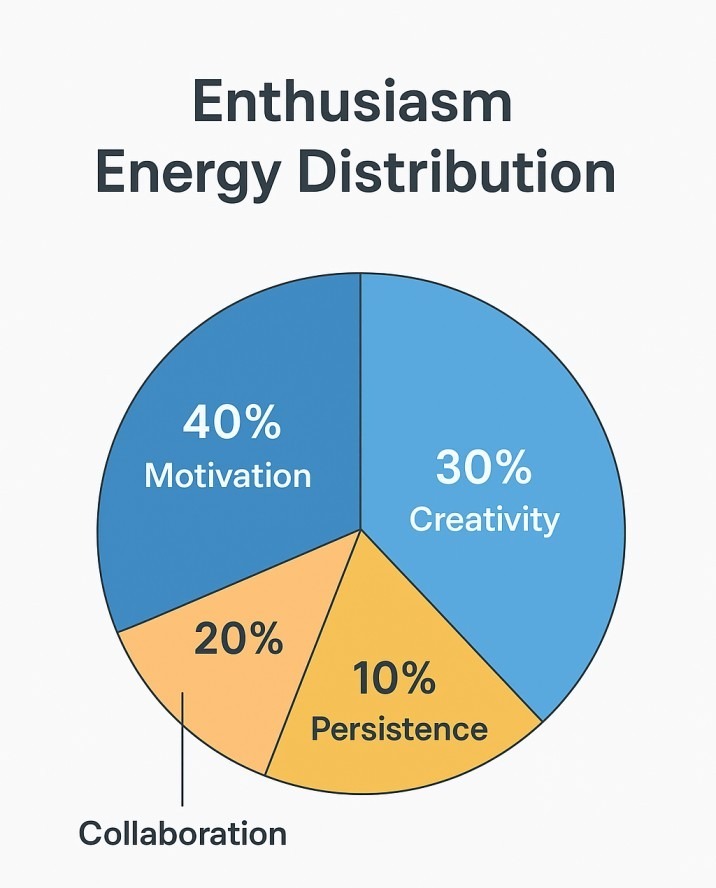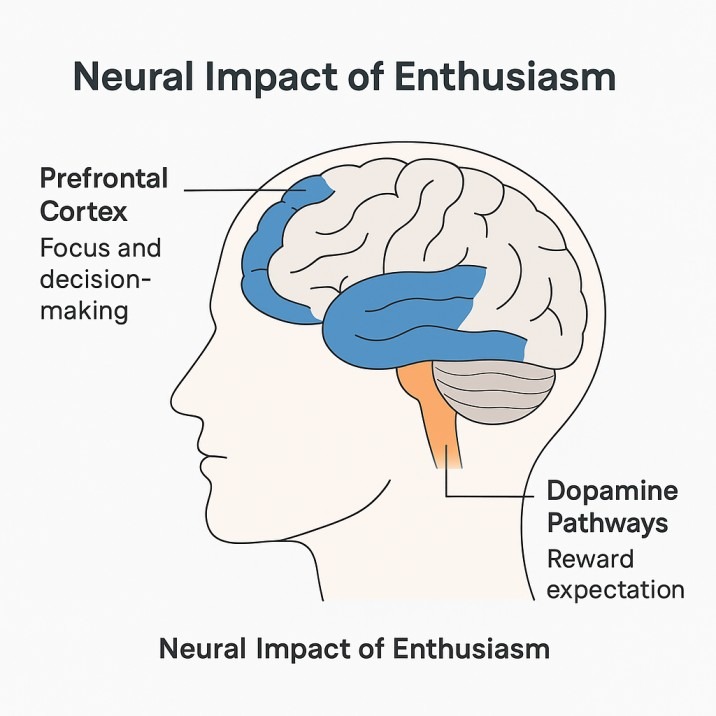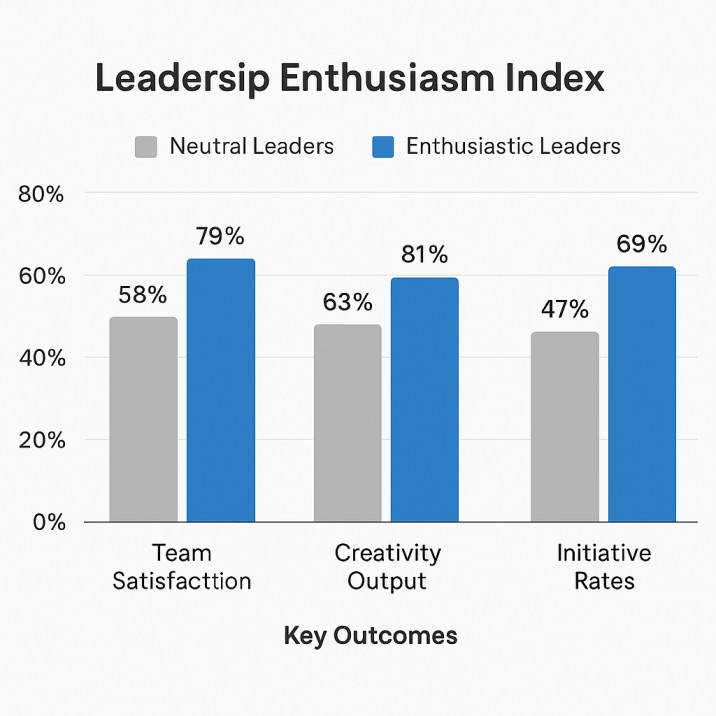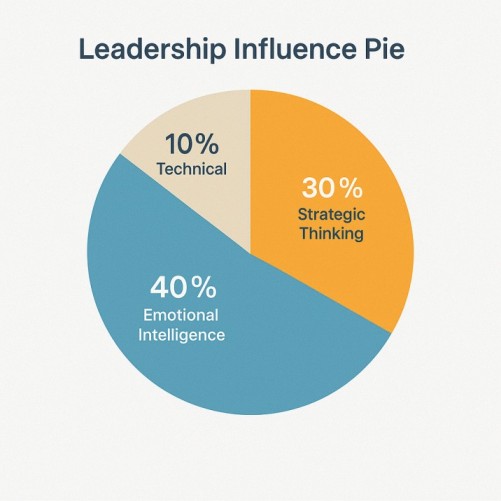In every workplace, project, or personal pursuit, enthusiasm acts as the invisible current that fuels progress. While discipline provides direction and persistence sustains effort, enthusiasm ignites action. It transforms ordinary goals into purposeful journeys, and its energy multiplies when shared. Understanding how enthusiasm shapes motivation and momentum helps explain why some teams thrive under pressure while others fade despite having talent or resources.
Genuine passion isn’t a passing emotion; it’s a driving force that fuels inner determination and outward influence. When genuine energy fills a room, the entire atmosphere shifts. People become more engaged, creativity flourishes, and obstacles lose their weight. This unseen spark doesn’t just make work fulfilling — it makes achievement unavoidable.
Enthusiasm transforms intention into action and sustains motivation through energy and connection. It inspires creativity, strengthens teamwork, and fuels resilience under pressure. When nurtured with purpose, enthusiasm becomes the driving force behind lasting momentum, turning ordinary effort into collective achievement that continues even when challenges arise.
Enthusiasm as the Emotional Engine of Motivation

Motivation often begins as intention, but enthusiasm turns that intention into momentum. When an individual feels deeply connected to a purpose, enthusiasm transforms effort from something required into something desired. It’s the emotional engine behind every act of perseverance. Without enthusiasm, even a well-structured plan feels heavy; with it, challenges become opportunities for expression.
Leadership studies show that passion is contagious. Teams exposed to enthusiastic leaders report higher engagement, faster task completion, and stronger emotional resilience. The brain interprets enthusiasm as social safety — a signal that taking initiative or risking creativity won’t result in punishment. That safety converts into motivation, creating a loop of trust and drive.
The Science Behind Enthusiasm and Momentum
Neuroscience identifies enthusiasm as a blend of dopamine-driven reward anticipation and oxytocin-fueled connection. When enthusiasm is present, the brain activates reward pathways that encourage continued effort. This biological reinforcement explains why enthusiasm feels self-renewing — every success amplifies it, and every setback softens under its influence.
Momentum, on the other hand, emerges when enthusiasm maintains consistency. Short bursts of motivation fade, but sustained passion keeps movement steady. Once individuals link progress to pleasure, the work becomes self-propelling. Studies from the Journal of Applied Psychology show that employees who describe themselves as “enthusiastically engaged” outperform others by 35% in long-term task persistence, regardless of skill level.

How Passion Amplifies Team Dynamics
Enthusiasm in groups functions like a shared heartbeat. A single motivated individual can influence collective mood, but a consistently enthusiastic leader can transform culture. When enthusiasm becomes normalized, teams communicate more openly, solve conflicts faster, and maintain forward motion even during setbacks.
In high-performing organizations, enthusiasm is treated as a strategic asset. It’s not left to chance — it’s cultivated through recognition, autonomy, and visible progress. Teams that feel their passion is valued tend to sustain higher morale even when resources are limited. The momentum built from mutual passion is exponential because shared energy multiplies, not divides.
Reigniting Enthusiasm During Burnout
Even the most driven professionals face moments when enthusiasm dims. Burnout, stress, or repeated failure can mute emotional energy. However, unlike motivation, enthusiasm is easier to restore because it’s rooted in curiosity and connection, not obligation. Revisiting purpose — why a project matters, or how it aligns with values — can reignite enthusiasm faster than external incentives.
When enthusiasm is reignited, the body responds physiologically: posture improves, speech quickens, and optimism returns. This behavioral shift affects others too. Colleagues sense renewed purpose, mirroring the enthusiasm through emotional contagion. The result is a refreshed collective drive, often stronger than before.
Enthusiasm as the Invisible Leadership Advantage
Leadership without enthusiasm is like navigation without wind. Managers may issue direction, but progress feels forced. Enthusiasm, however, creates voluntary alignment. Employees follow not because they must, but because they want to be part of something energized and meaningful.
Passion in leadership is authenticity made visible. When a leader genuinely believes in a mission, that belief transfers. It bypasses rational skepticism and taps into emotional buy-in. Harvard Business Review reports that teams led by visibly enthusiastic managers show 21% higher satisfaction and 18% greater retention rates. The reason isn’t charisma; it’s trust. People interpret consistent passion as a sign of emotional stability — the kind of presence that anchors teams amid uncertainty.

Sustaining Passion Through Purpose and Reflection
Sustaining enthusiasm requires rhythm, not perfection. The most enthusiastic individuals are not endlessly cheerful — they’re purpose-driven and emotionally self-aware. They understand that passion can dip, but they also know how to recharge it through reflection, gratitude, and growth.
Momentum thrives when enthusiasm meets direction. Without a sense of purpose, enthusiasm disperses; without enthusiasm, purpose stagnates. The intersection of both forms what psychologists call intrinsic drive — a self-fueling state where joy, focus, and ambition coexist. In this state, progress becomes organic and sustainable.

The Ripple Effect: Passion as a Cultural Force
Organizations that harness enthusiasm as a cultural pillar evolve faster. They attract talent that values energy and optimism, and they weather crises with agility. When enthusiasm becomes cultural, it reshapes how people see challenges — not as threats, but as opportunities to contribute.
Momentum, once rooted in passion, doesn’t just belong to individuals; it belongs to systems. Every department, meeting, and initiative reflects the tone set by its most enthusiastic participants. The real transformation happens when enthusiasm stops being reactive and becomes structural — a habit of thinking, not a burst of emotion.
The result is a sustained cycle: enthusiasm builds motivation, motivation sustains momentum, and momentum reinforces enthusiasm again. The loop becomes self-perpetuating, ensuring that teams move forward not just efficiently, but passionately.
Conclusion
At its essence, enthusiasm is more than positivity — it’s energy with direction. It turns the mundane into meaningful and the difficult into possible. In professional and personal contexts alike, enthusiasm is the fuel that keeps effort alive long after logic suggests stopping.
Every innovation, every movement, every remarkable story began with enthusiasm — the conviction that something could be better, brighter, or more significant. And once that conviction spreads, momentum becomes unstoppable.
Enthusiasm is both spark and engine — the origin of motivation and the motion of progress. When nurtured with purpose, it becomes not just a feeling, but a force.
Andrea Balint is a writer and researcher focused on human behavior, workplace psychology, and personal growth. Through her work at CareersMomentum, she explores how mindset, leadership, and emotional intelligence shape modern careers. With a background in communication and HR development, she transforms complex ideas into practical insights that help readers build clarity, confidence, and professional purpose.
